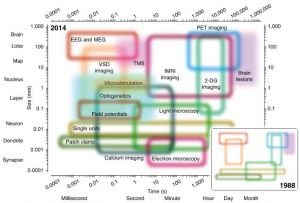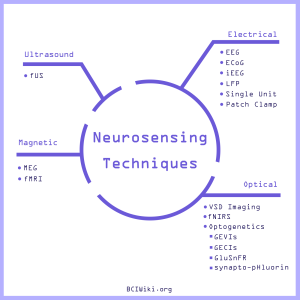If you're interested in becoming a contributor or requesting changes then click here to join the discord
Difference between revisions of "Category:Neurosensing Techniques"
Jump to navigation
Jump to search

Landonodnal (talk | contribs) |
Landonodnal (talk | contribs) |
||
| (One intermediate revision by the same user not shown) | |||
| Line 1: | Line 1: | ||
Neurosensing, also called neuromonitoring, is the use of neuromonitoring/functional neuroimaging technology to measure an aspect of brain function, often with a view to understanding the relationship between activity in certain brain areas and specific mental functions. | Neurosensing, also called neuromonitoring, is the use of neuromonitoring/functional neuroimaging technology to measure an aspect of brain function, often with a view to understanding the relationship between activity in certain brain areas and specific mental functions. | ||
| + | [[File:The spatiotemporal domain of neuroscience.jpg|thumb|"The spatiotemporal domain of neuroscience and of the main methods available for the study of the nervous system in 2014." Source: https://www.ncbi.nlm.nih.gov/pmc/articles/PMC4224030/]] | ||
| + | [[File:Neurosensing_techniques.png|thumb|Map of neuromonitoring and functional neuroimaging techniques used for brain-computer interfaces]] | ||
Latest revision as of 22:22, 16 November 2023
Neurosensing, also called neuromonitoring, is the use of neuromonitoring/functional neuroimaging technology to measure an aspect of brain function, often with a view to understanding the relationship between activity in certain brain areas and specific mental functions.

"The spatiotemporal domain of neuroscience and of the main methods available for the study of the nervous system in 2014." Source: https://www.ncbi.nlm.nih.gov/pmc/articles/PMC4224030/
